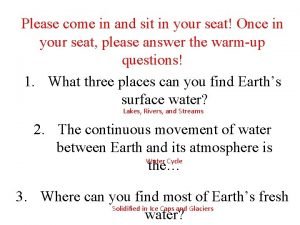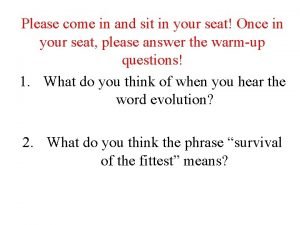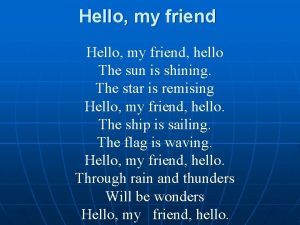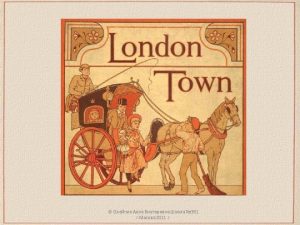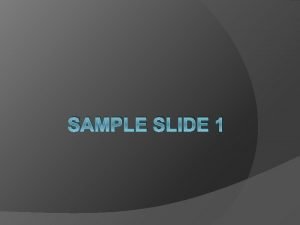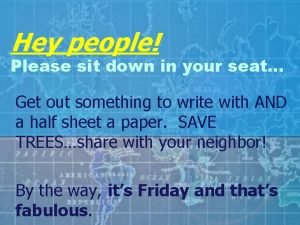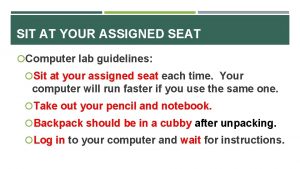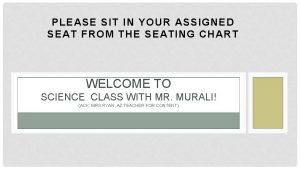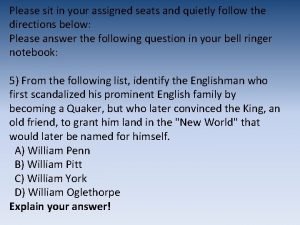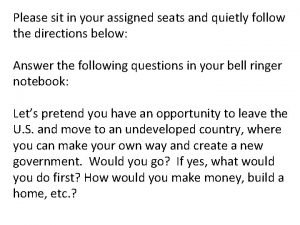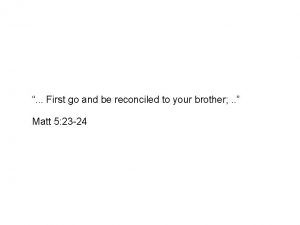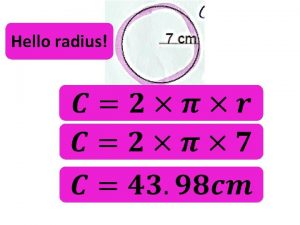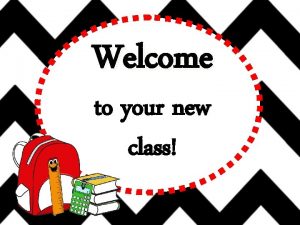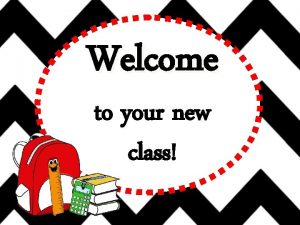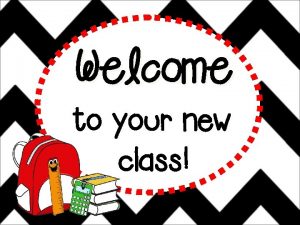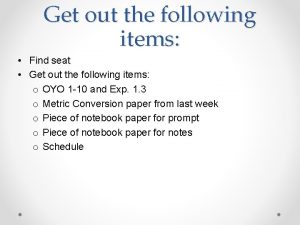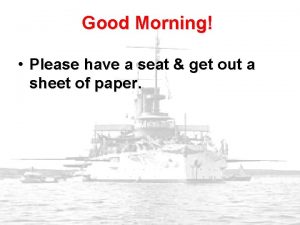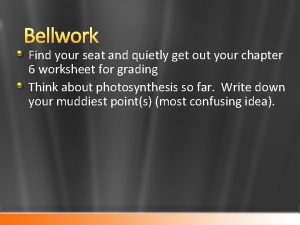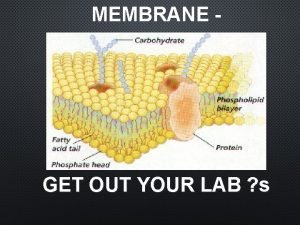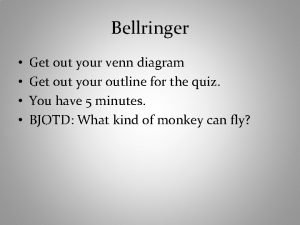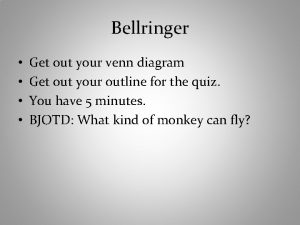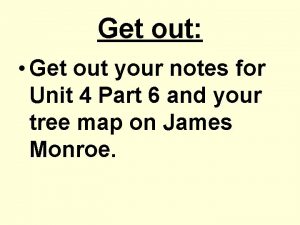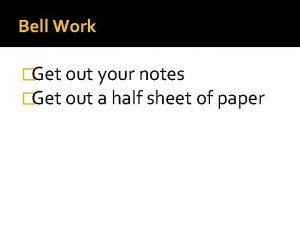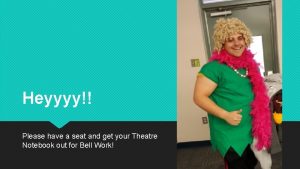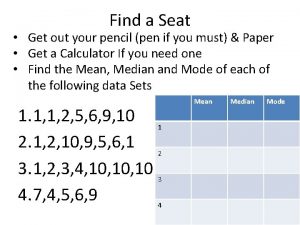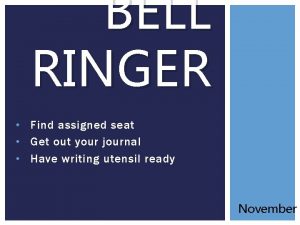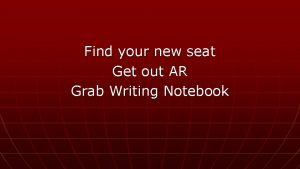HELLO HAVE A SEAT AND GET OUT YOUR





































- Slides: 37

HELLO, HAVE A SEAT AND GET OUT YOUR THEATRE NOTEBOOK,

BELL WORK Try to write detailed directions on how to walk to your next class. Example: walk out of the room, turn left, follow the sidewalk past the grassy area…. . etc….

WARM-UP ZAP!

OPEN UP TO YOUR CLASS NOTES (MIDDLE SECTION)

OUR OBJECTIVE TODAY! Students will understand the 9 blocks of the stage and why/how stage directions are used.

Stage Directions 4 I understand the purpose and can identify stage directions AND I can teach it. 3 I understand, can explain the purpose and identify stage directions 2 With help, I can explain the purpose and identify stage directions 1 Even with help, I can’t really explain the purpose or identify stage directions 0 I know nothing about stage directions…yet!

PLEASE WRITE DOWN THE VOCAB IN BLUE

BLOC KING What is it? Why do we need it?

BLOCKING v. Blocking refers to the pre-planned movement on the stage. v. Much like choreography is pre-planned dance moves, blocking is pre-planned walking, running, sitting, standing, etc. v. But…. how do directors plan out the blocking? Well, they use stage directions.

STAGE DIRECTIONS v. Much like we use North, South, East and West to give directions, Director’s give their actors specific stage directions to tell them where to go on the stage. v. Actors learn the various “blocks” of the stage and must learn to move to those areas when directed to do so. v. There are 9 blocks of the stage


DOWNSTAGE v. Downstage is the area closest to the audience v. Why is it called “downstage”?

BELL WORK Can you name all 9 blocks of the stage?

UPSTAGE v. Upstage is the area near the back of the stage. This is the opposite of downstage. v. When you’re walking upstage, you’re walking away from the audience.

STAGE RIGHT / STAGE LEFT v. Stage right and left are defined by the actor’s viewpoint, NOT the audience. v. If an actor is onstage and the director tells him to move stage right, the actor will move to his right. Stage left Stage right


HOUSE RIGHT / LEFT HTTP: //DICTIONARY. TDF. ORG/STAGE-LEFT-STAGE-RIGHT-HOUSE-LEFT-HOUSE-RIGHT/ v. House right and left refer to the audience’s viewpoint…which is often where the director is sitting during rehearsals. House left House right

CROSSING ON THE STAGE When a director wants an actor to move from one part of the stage to another…they will use the term “cross”. “I want you to cross stage right” left” “Cross downstage

WHY DO WE CALL IT “CROSSI NG”?

Let’s rate ourselves again… if you stated at a 0, 1, or 2… where are you now? Add it to the bottom of your notes WE WILL GLUE THIS SHEET ONTO A BLANK PAGE OF THE CLASS NOTES SECTION Before you glue, fill out this box

HI. HAVE A SEAT AND GET OUT YOUR THEATRE NOTEBOOK, PLEASE

BELL WORK Where do you think is the best place to sit in the audience when you go see a play or a sporting event? The front row? The back row? To the side? Right in the middle? Up high? WHY? ? ?

WARM- Murder-by-Wink

WARM- Communication

TYPES OF STAGES

PROSCENIUM HTTPS: //WWW. YOUTUBE. COM/WATCH? V=I 9 N 2 XC 3 N 6 SC Proscenium arch This is the most common type of theatre. The prosceniu m arch acts as a frame

POSITIVES AND NEGATIVES OF THE PROSCENIUM STAGE

IN THE ROUND/ARENA THEATRE HTTP: //DICTIONARY. TDF. ORG/THEATRE-IN-THE-ROUND/ Vomitorium In this theatre, the stage is surrounde d by seats on all sides. Most sporting events take place in an arena

POSITIVES AND NEGATIVES OF THE ARENA STAGE/THEATRE IN THE ROUND

THRUST STAGE HTTP: //DICTIONARY. TDF. ORG/THRUST-STAGE/ Vomitoriu m The thrust theatre’s stage extends out into the audience so that audience members are on 3 sides.

POSITIVES AND NEGATIVES OF THE THRUST STAGE

ADD THIS TO CLASS NOTES: Stage Presence v. Three ways to put focus on a certain character/action on stage: v. Three options of motivation to move/to cross the stage: Types of Stages v. List three types of stages and draw them. Give a positive & negative for each Proscenium, In the Round (arena), Thrust

STAGE DIRECTION OLYMPICS

HI. HAVE A SEAT NO NOTEBOOKS TODAY

WARM UP Knots!

WARM UP Boppity Bop!

STAGE DRAWING v. Select a type of stage (proscenium, thrust, arena/in the round) v. Write 3 facts about the stage on the back v. Draw and color the stage v. Create a stage picture with actors on the stage… who has the focus and how are you showing that? v. Include the audience, too!
 Hello hello hello hello hello
Hello hello hello hello hello Figurative language in one thing by one direction
Figurative language in one thing by one direction Get on get in get off
Get on get in get off Hello good morning what's your name jenny
Hello good morning what's your name jenny Hello hello hello how are you
Hello hello hello how are you Please sit down and your seat belts
Please sit down and your seat belts Come in and ....................... a seat!
Come in and ....................... a seat! Hello my friend hello my future
Hello my friend hello my future Good afternoon everyone,
Good afternoon everyone, Hello hello nursery
Hello hello nursery Hello my friend hello song
Hello my friend hello song Hi hi good morning
Hi hi good morning Small head fat body
Small head fat body Hello hello to everyone it's english time
Hello hello to everyone it's english time Index.php?page=
Index.php?page= I am muzzy
I am muzzy Hello pt
Hello pt Hello i am peter
Hello i am peter Please sit down and your seat belts
Please sit down and your seat belts Good morning please have a seat
Good morning please have a seat Theobald von bethmann hollweg
Theobald von bethmann hollweg Good afternoon sign
Good afternoon sign Good morning please have a seat
Good morning please have a seat Good morning please have a seat
Good morning please have a seat You put your right foot in you put your right foot out
You put your right foot in you put your right foot out Sit in your assigned seat
Sit in your assigned seat Sit in your assigned seat
Sit in your assigned seat Sit in your assigned seat
Sit in your assigned seat Sit in your assigned seat
Sit in your assigned seat Get up get moving quiz
Get up get moving quiz Get up get moving quiz
Get up get moving quiz Get up get moving quiz
Get up get moving quiz Sequence pseudocode
Sequence pseudocode Get focused get results
Get focused get results Get up get moving quiz
Get up get moving quiz All six faces are square with 12 edges and 8 vertices
All six faces are square with 12 edges and 8 vertices Hi good morning nice to meet you
Hi good morning nice to meet you First go and be reconciled to your brother
First go and be reconciled to your brother





